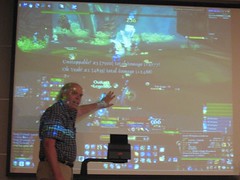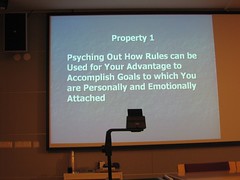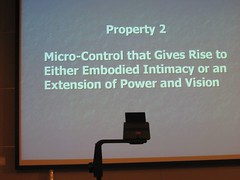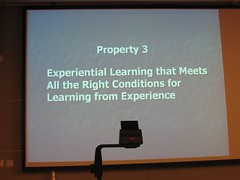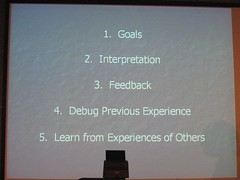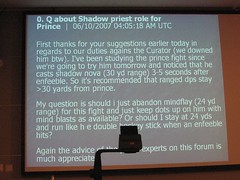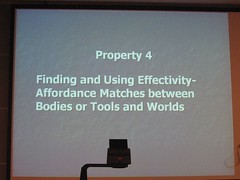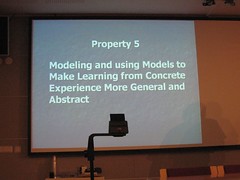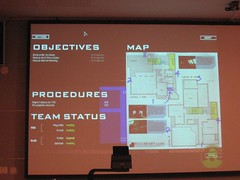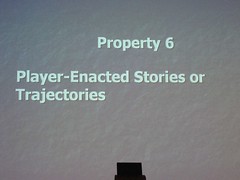Freefrom notes from GamesInAction Conference in Gothenburg 14th of May.
Keynote: James Paul Gee. 9.15 – 10.15
Important to recognise the various types of games. How they can be used for learning.
Question: …. Serious games movement spreading over the
What are the deep properties of Publish Postthat type of games, why so compelling?
Could we do that for something different than entertainment, do for education?
If you can’t have all properties, which can you drop off, and what would that cost you.
Core games with deep properties.
Half-Life. Screen.
Text slide property 1
Psych out a system, or game out a system…. Similar to what gaming is for gamers. Find the patterns, learn them, and use them to your advantage. Optimise, achieve own goals…
In a good game you try to accomplish the goals set by the design, but in your own way.
screen2…
Never been a hip hopper before
Screen 3 Stalker, Russian game
Pollution. Challenge: find out what the rules are.
Property 2
Micro control. Like over your own body. Your foot. Or if blind, a cone. Which feels like an extension of the body? Micro control a little bit further than the body.
Screen Prince of
The avatar and the control over the body of the avatar. Fine degree of micro control. Your body artificially extended. Like the blind mans cane. “I died” one says… not “my avatar died”
With different designs of the avatar one can achieve different things. Important for learning. Body needs to be there. Fundamental to learning. Joy of Prince of Persia to use the body of the avatar.
Why was the first body like this female, Lara Croft?
Or control a group of avatars. Loose intimacy but getting another scope.
God games… entire world, fully lost intimacy but gained gods eye. Being the centre of the universe.
Property 3
Learning through experience.
A list of five.
The shadow priest role.
How come people who are into wow can learn this – compare to chemistry book with arcane language? Difference = experience.
Prop 4
Affordances.
…Gibson argued around affordances in the world. Affordances for a hammer. Need a thumb. Need certain properties in order for an object to be affordable.
The body in metal gear solid, Solid Snake.
Far Cry. Shooter on a beautiful island. Can’t survive is stay and look at pretty fish. Eye candy irrelevant. Player needs to look through the eye candy. Snake need to sneak. In training session in MGS all eye candy is stripped out. Affordances for action for the body you’ve got.
Cheby Robo game. A cleaning robot. Clean a whole house being only 4 inches tall, a new challenge. Even cleaning becomes fun. Plus divorce going on, need to solve the marital problems.
Property 5
Modelling.
A map – a simplified model of a city. Foundation. Computer games encourage model based thinking. Scientific
Contradictory to experience by learning?
Gee argues no - kids love modelling… /* Yes, makes me think of my overview from yesterday of types of systems and the myriads of system we tend to build, all the individual category systems and ontologies we carry, and for syntax, the common game of building an own language that you speak with your best friend. */
Screen with a map and strategies how to go through a level. Need abstractions to prepare. Metathinking about the experience.
All games use models. Which to children seem boring in school. Tony Hawk skating. Also a model. Modelling a model, your skating.
Modding community in WoW.
The model is eating away at the experience! Hardly anything else on the screen. Model taking over.
Property 6
Player-Enacted Stories and Trajectories.
In wow, advance with other people. Massive number of trivial events creating texture and trajectory to the game. The story as a quilt. Quilts made of everyday things, like old jeans, out of trivia comes something artistic.
Property 7
Modding.
Picture of a ps2 controller showing a possible way to mod the Tony hawk skating game, so players can mod it to their liking.
Ppl as producers instead of consumers.
In education: let student’s mod the curriculum.
… Affordances that fit one’s power give flow.
Empathy for a Complex System.
Study through simulation in current science.
Projective identity.
Questions:
Staffan Björk: How much of these types of games, these deep properties, could they be used for games as for example board games?
Gee: hmm the more of these props a game has the better… make the problem of your game to fit. Not so many successful serious games made yet. These are the props that give leverage. Also in life. Going away from the
…Failure is fundamental for learning. Fail early and often. Games lower the cost of failure.
More photographs taken during the speech
